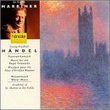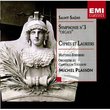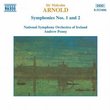| All Artists: Nielsen, Blomstedt, Sfs Title: Symphonies 1 & 6 Members Wishing: 0 Total Copies: 0 Label: Polygram Records Release Date: 1/5/1990 Genre: Classical Styles: Historical Periods, Modern, 20th, & 21st Century, Symphonies Number of Discs: 1 SwapaCD Credits: 1 UPC: 028942560727 |
Search - Nielsen, Blomstedt, Sfs :: Symphonies 1 & 6
 | Nielsen, Blomstedt, Sfs Symphonies 1 & 6 Genre: Classical
|
Larger Image |
CD DetailsSimilarly Requested CDs
|
CD ReviewsFrom Robert Layton's Review in Gramophone Record Collector | Mons, Belgium | 04/19/2006 (5 out of 5 stars) "I liked Blomstedt's account of the Fourth and Fifth Symphonies (Decca CD), and as some readers will recall, he recorded for EMI not only the six symphonies but Nielsen's complete orchestral works (including the three concertos) with Danish Radio forces in the mid-1970s for EMI. The intervening years have found him developing in stature and his Bruckner Fourth and Seventh Symphonies with the Staatskapelle Dresden on Denon show a very real depth and mastery.
Let's start with the First Symphony, for which Nielsen always nurtured a special affection-and rightly so, for its language is natural and unaffected, it has spontaneity of feeling and a Dvorakian warmth and freshness. To my mind this newcomer is the best account of the work to have appeared for some years: indeed, I'm tempted to say, since the 1967 Previn/LSO account on RCA. It is vital, beautifully shaped and generally faithful to both the spirit and the letter of the score. Tempo markings are observed, though Blomstedt is considerably slower than Nielsen's crotchet=120 in the Andante sostenuto section of the scherzo, which is a pity as it relates to the minim=120 of the finale which he does observe. Otherwise he is completeiy on target and even observes a piu vivo marking in the finale (eight bars after fig. E; track 4, 1'37'') which in Jensen's pioneering Decca version is barely perceptible. Blomstedt achieves a finely blended wind sound and cultured string playing and although the music is not borne on so highly charged a current as with Jensen's, I would prefer to hear this version before any of those listed above. The recording is good, though the Davies Symphony Hall, San Francisco has more clarity than warmth. All the same, the sound has plenty of room to expand. There is also a very good relationship between the various sections of the orchestra and a realistic back-to-front perspective. Blomstedt gives a powerful account of the Sixth Symphony too, with plenty of intensity and an appreciation of its extraordinary vision. It is by far the most problematic and challenging of the cycle. He opts for a much faster tempo than did Jensen in his 1952 Danacord/Conifer recording--I quote Jensen simply because he is said to have had a particularly good feeling for Nielsen's tempo markings, having played under the composer, and his much broader opening proves stronger in atmosphere. There is (as I see it) an undercurrent of foreboding that escapes Blomstedt in these opening pages, as indeed it did in his mid-1970s version. Mind you, there is much more that he succeeds in penetrating the powerful nervous tension later on in the movement, and the depth in the 'Proposta seria'. Ole Schmidt and the LSO on Unicorn-Kanchana comes as part of a three-CD set of all six symphonies, and is neither as well played nor as well recorded as this Decca newcomer. Yet Schmidt still has something special to say and opens up the world of this strange and visionary symphony with all its disturbing overtones. Yet had I never heard the Jensen or Schmidt performances, I would have few reservations about this newcomer. Blomstedt brings one into closer contact with the music than he did in his Danish performances and conveys much of its power and, in the finale, humour. Both these new performances are recommended, though you should not miss hearing the Schmidt. Unicorn-Kanchana should reissue it separately, coupled, as it is in the complete set, with his fine account of the Fifth. " |

 Track Listings (8) - Disc #1
Track Listings (8) - Disc #1








